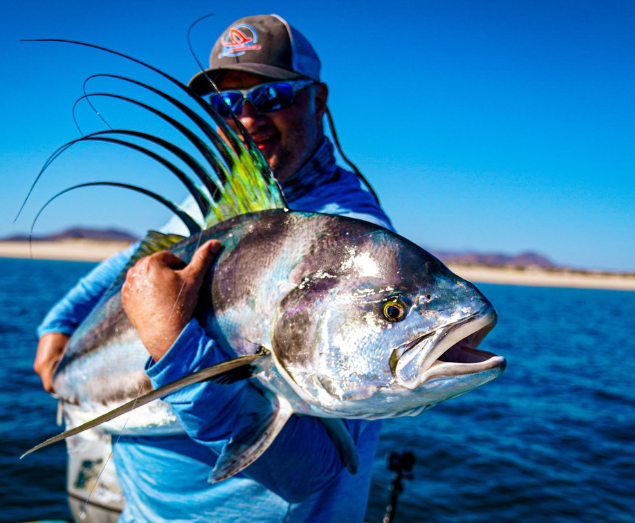No products in the cart.
Return To ShopOUR ADVENTURES
Our Species
Meet the Roosterfish..
While their local name “El Grande Pesca Gallo”, or The Giant Roosterfish, is a mouthful, our lodge’s namesake is mostly called Roosterfish, Rooster or “bastard” on the rare occasion one gets away from us, and they are the star of the show!
Recognized by it’s seven-pronged top fin, thought by many to look like a rooster’s “comb”, these colorful beauties typically weigh in around 20 pounds but can range up to over 100. Even roosters on the smaller end of this scale are a force to be reckoned with. For my money, as their fin cuts the water, it reminds me more of Freddy Kruger’s bladed gloves than a rooster, and the fight they put up can make you feel like you’re in a dream that never ends. But the excitement of pulling one in after a hard-fought battle is what it’s all about, and we want to celebrate those moment’s with you, so here’s a little advice.
The Roosterfish is not a prey for the faint of heart, and you’ll need to bring your A game when it comes to casting.

We recommend practice at changing casting directions quickly, as these silvery giants cut their patterns through the water. A Rooster will smash something at the surface, and be a hundred yards away before you can even get a cast off. Anticipation is the name of the game when we’re hunting these bad boys. If you can’t get your fly ahead of them before it they go down, you’re out of luck.
Roosterfish are ferocious when feeding, but you’d better look quick, because once you’ve seen them, you might not see that fish again for thirty to forty-five minutes. They are smart, fast and hard fighting. They make a worthy opponent for even a master fly fishermen, so pay attention to the advice of your captain to have your best chance at getting a nice selfie with one of these beauties.
Introducing the Mahi Mahi..
Like a lot of other species, the Mahi Mahi is known by many names. Officially, the International Game Fish Association dubs them dolphinfish, and in some regions they are known as Dorado, but in the region around La Paz, the locals call them Mahi Mahi. Here at El Gallo, we call them beautiful. If you’ve ever seen photos of a Mahi Mahi, you might not understand just how colorful and amazing this fish is. The camera just can’t quite capture it.
While a lot of the photos you’ll find online are fish that have spent half a day in a cooler before being photographed, even our photos of them pulled fresh out of the sea can’t quite measure up.Named for their forehead, which gives them a dolphinesque appearance, these gorgeous beauties typically weigh in at 15 to 30 pounds, with rare monsters coming in at over 40.
As an opponent, Mahi Mahi, Hawaiian for “Very Strong”, are jumpers when hooked, and can bolt like a quarter horse when running. They often make you think they’re giving up, only to find another burst of energy and tearing off again. In the late summer and early fall months of August through the end of October, we have a lot of fun catching Mahi Mahi in big numbers here at El Gallo.

Like a hunt? Meet the African Pompano..
More elusive than the Roosterfish, the Pompano ranges from 2 to 4 feet in length, and holds a record weight of 50 pounds. Their fluorescent silvery scales glisten like diamonds in the light and they are fun to catch. We find these guys hanging out in the deeper stretches of our beach front where they like to feed on Sarinas and other small baitfish.
The pompano is a formidable fighter, that can often put up a struggle worthy of a much larger fish. It’s best to avoid heavier leaders when going after these delightful creatures. They seem to be a bit smarter than some of our prey, and can be leader shy.
Prefer Yellowtail? Spring is your season
These migratory fish come through the La Paz region in the Early Spring and if you’re here at the right time, you’re in for a treat. They mostly prefer warmer waters, living year round further south, and only stopping through for a few weeks each year, here in the Northern hemisphere.
They’re commonly referred to as Rainbow Runners. Unlike many of the deeper bodied fish we catch at El Gallo, the Yellowtail features a slimmer, more cylindrical body, they can grow up to four feet long, and as much as 70 or 80 pounds, with most specimens being a little smaller. This is a fun fish on lighter tackle and will give you a good fight. They also happen to make some of the best sashimi I’ve ever eaten. (we put the fish in the sashimi, they don’t actually make it themselves)
Prefer Yellowtail? Spring is your season
These migratory fish come through the La Paz region in the Early Spring and if you’re here at the right time, you’re in for a treat. They mostly prefer warmer waters, living year round further south, and only stopping through for a few weeks each year, here in the Northern hemisphere.
They’re commonly referred to as Rainbow Runners. Unlike many of the deeper bodied fish we catch at El Gallo, the Yellowtail features a slimmer, more cylindrical body, they can grow up to four feet long, and as much as 70 or 80 pounds, with most specimens being a little smaller. This is a fun fish on lighter tackle and will give you a good fight. They also happen to make some of the best sashimi I’ve ever eaten. (we put the fish in the sashimi, they don’t actually make it themselves)
